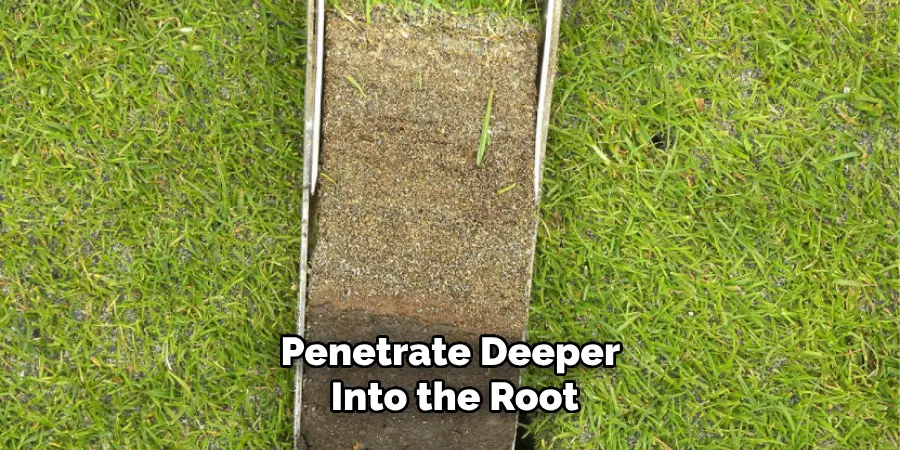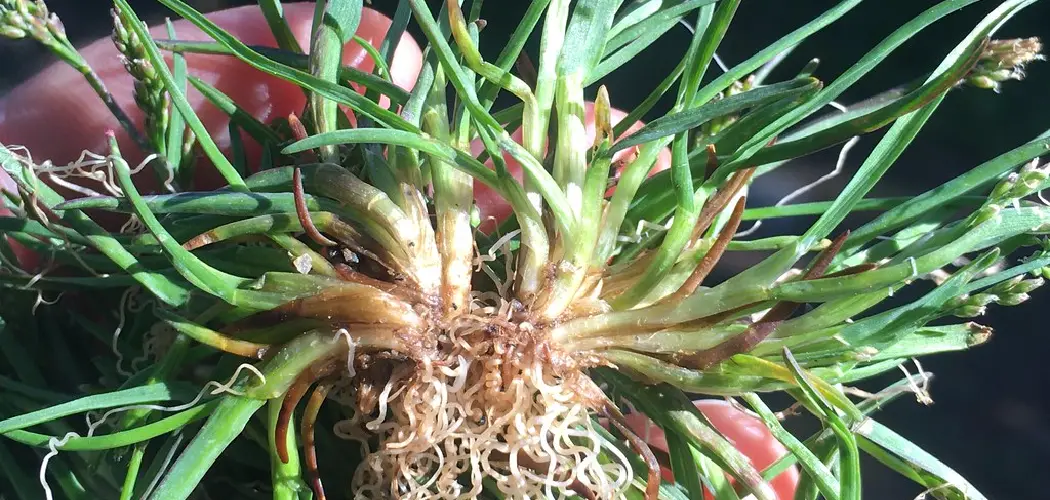A healthy lawn can add value to your home, beautify your property, and enhance the overall look of your neighborhood. However, to ensure that your lawn stays healthy, you must ensure its roots are strong. Strong roots help the grass withstand extreme weather conditions, pest attacks, and foot traffic. In this blog post, we’ll share some tips and tricks on how to make grass roots stronger.

Can You Make Grass Roots Stronger?
A beautiful lawn is the pride of any homeowner. To make your lawn look lush and green, focusing on developing the roots rather than just the surface is essential. By strengthening the roots of your lawn grass, you ensure your lawn remains healthy throughout the year. There are several ways to strengthen your grass roots, including investing in good soil, proper watering, and mowing techniques.
You can also apply fertilizers and organic supplements to improve the nutrient content of the soil, which in turn helps in the growth of stronger roots. So, if you want to make your lawn look more robust and attractive, focusing on root development is the way to go.
Why Should You Make Grass Roots Stronger?
A lush, green lawn is a beautiful sight and a source of pride for many homeowners. But achieving and maintaining that healthy lawn takes more than just regular watering and cutting. Strengthening the grass roots is the key to a durable and resilient lawn that can withstand the stresses of daily use, weather fluctuations, and pests.
When grass roots are strong, they can absorb water and nutrients more efficiently, grow deeper and denser, and resist disease and damage. By taking simple steps like aerating, fertilizing, and choosing the right grass type, you can help your lawn roots thrive and enjoy the benefits of a healthy and vibrant lawn for years to come.
How to Make Grass Roots Stronger – Tips and Tricks
1. Invest in Good Soil Quality
The soil quality plays a significant role in determining the strength of your grass roots. If your lawn soil has poor drainage and is compacted, the grass roots will find it challenging to penetrate the soil.
Adding organic matter like compost or grass clippings is one way to ensure good soil quality. This will help in creating a healthy soil structure and improve soil drainage. You can also rent or buy soil aerators to loosen up compacted soil.

2. Opt for Deep Watering
Shallow watering leads to shallow roots. Get yourself a soaker hose and water your lawn deeply. The frequency may vary depending on the weather conditions, but the watering duration should not change. Experts recommend that you water your lawn to a depth of 6 inches. This will encourage the roots to grow deeper into the soil, strengthening them.
3. Avoid Over-fertilizing
Over-fertilizing your lawn may encourage fast growth, but it weakens the roots. If your grass is growing too quickly, reduce the amount of fertilization. This will force the roots to grow deeper and strengthen themselves. Use a slow-release fertilizer with the right nitrogen, phosphorus, and potassium balance.
4. Best Time to Mow
The best time to mow your lawn is when the grass is dry and upright. Mowing wet or bent grass can lead to uneven cuts, clippings that clump, and excessive water retention on the lawn’s surface. Always follow the one-third rule for mowing. Never cut more than one-third of the grass blades’ length in a single mowing.
5. Aerate Your Lawn Regularly
Aerating your lawn is critical because it allows oxygen, water, and nutrients to reach deeper into the soil, supporting the growth of stronger roots. You can rent a machine for a day or hire a professional to aerate the soil for you. Remember that the best time to aerate your lawn is during the fall or spring when grass growth is at its peak.
6. Choose the Right Grass Type
When establishing a new lawn, choose a grass variety that suits your climate and soil type. Some types of grass have stronger roots than others, so do your research beforehand. Following the proper seeding and watering instructions for your chosen grass type is also essential.

7. Keep an Eye on Pests
Pests like grubs can cause significant damage to your lawn by eating away at the roots. To keep them under control, regularly inspect your lawn for signs of pests and take appropriate measures if you spot any.
Avoid using harsh chemicals and opt for natural pest control methods when possible. Keeping your lawn healthy and pest-free will help maintain strong grass roots.
These seven tips are just some ways you can strengthen your grass roots. Remember, a healthy lawn starts from the ground up, so investing time and effort into improving soil quality, deep watering, proper mowing and fertilization, aeration, choosing the right grass type, and pest control will result in stronger grass roots and beautiful, lush lawn. So be sure to follow these tips and watch your lawn thrive!
5 Considerations Things When You Need to Make Grass Roots Stronger
1. Soil Testing
Testing the soil is the first step to making your lawn grass roots stronger. This will help you determine what nutrients are missing from the soil and what amendments must be added. Additionally, testing the pH levels of the soil can help you determine which grasses are best suited for your area.
2. Fertilizing
Fertilizing your lawn is essential for keeping it healthy and strong. A balanced fertilizer with nitrogen, phosphorus, and potassium can help promote strong root growth and encourage lush green growth. It is important to use a fertilizer specifically designed for lawns to get the best results.
3. Aerating
Aerating your lawn helps to loosen compacted soil and allow air, water, and nutrients to penetrate deeper into the root zone of your grass. This will help promote stronger root growth and improve drainage in areas where water tends to pool on the surface of the lawn.

4. Watering Properly
Watering properly is key in making your lawn grass roots stronger. Over-watering can cause shallow roots, while under-watering can cause deep roots more prone to drought stress and disease problems. It is best to water deeply but infrequently to encourage deeper root growth while conserving water at the same time.
5. Mowing Height
Mowing height plays an important role in making your lawn grass roots stronger as well. Keeping your mower blades set higher helps shade weeds while encouraging deeper root growth by allowing more leaf area for photosynthesis and nutrient absorption from the soil below.
5 Benefits of Making Grass Roots Stronger
1. Improved Soil Quality
A strong root system in your lawn grass can help to improve the quality of the soil it grows in. Healthy roots can absorb more nutrients from the soil, which helps to ensure that your lawn has the necessary nutrients for healthy growth.
Additionally, strong roots are able to penetrate deeper into the soil, which helps to aerate and loosen compacted soils. This allows water and air to move through the soil more easily, giving your lawn a better chance of thriving.
2. Reduced Erosion
Strong roots also help to reduce erosion by binding together the soil particles and creating a stronger foundation for your lawn grass. This helps to keep soils in place during heavy rains and storms, preventing them from being washed away or carried away by wind. Additionally, strong roots help to hold moisture in the soil longer, reducing runoff and helping your lawn stay hydrated during dry periods.

3. Improved Weed Resistance
A strong root system in your lawn grass can also help it resist weeds more effectively. Weeds often have shallow root systems that cannot compete with deep-rooted grasses for resources such as water and nutrients. As a result, weeds are less likely to take over areas with healthy lawn grass with deep roots that can outcompete them for resources.
4. Better Heat Tolerance
Grasses with strong root systems are also better able to tolerate heat than those with weak ones. When temperatures rise, deep-rooted grasses can access stored moisture deeper down in the soil profile, which helps them survive periods of drought or extreme heat more effectively than shallow-rooted varieties. This makes them less likely to suffer from heat stress or die off due to high temperatures than their weaker counterparts.
5. Increased Disease Resistance
Finally, having a strong root system can help your lawn grass be more resistant to disease and pests, as well as environmental stresses such as heat or drought conditions.
Healthy roots are better equipped to take up essential nutrients from the soil, which can help strengthen their defenses against diseases and pests while also making them better able to withstand harsh environmental conditions like extreme temperatures or prolonged periods of drought
Some Common Mistakes People Make When Trying to Make Grass Roots Stronger
Having a lush, green lawn is the goal of most homeowners, but achieving and maintaining that requires some effort and knowledge. Unfortunately, many people make mistakes in strengthening their lawn grass roots. One of the most common mistakes is overwatering, which leads to shallow roots and fungal growth. Another mistake is mowing the grass too short, which puts stress on the roots and hinders their growth.
Fertilizing too much or applying the wrong type of fertilizer can also harm grass roots. Finally, neglecting to aerate the soil can compact the earth and make it difficult for water and nutrients to reach the roots. While it may seem like a small issue, taking care of lawn grass roots is crucial for a beautiful and healthy lawn.
Conclusion
In conclusion, making your lawn grass roots stronger is vital for maintaining the health of your lawn. We hope our above tips and tricks will help you achieve a lush, green, and healthy lawn. Consistency and patience is the key. It will take some time for your roots to grow deep and healthy, but it will be worth all the effort.
Do follow these tips to increase the chances of having a healthy and robust lawn that looks great all year round. Thanks for reading our post about how to make grass roots stronger.

